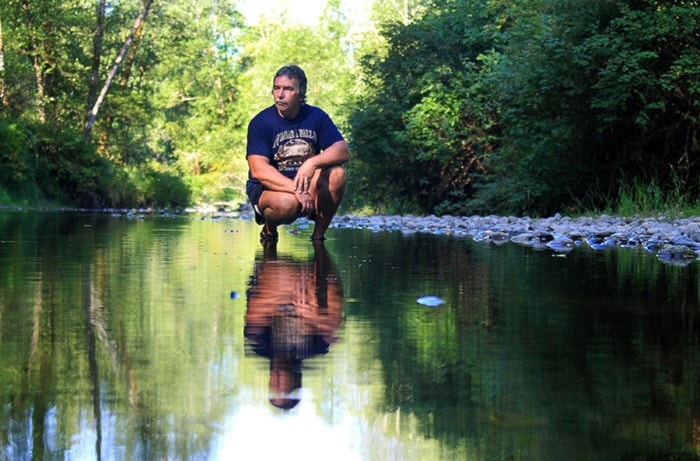Low water levels and warming temperatures have prompted the province to ban angling in most streams and smaller rivers across the South Coast region.
The unusual drought conditions make fish vulnerable and the closures are required to protect stocks, according to provincial government officials, and will remain in place until Sept. 30.
Ross Davies, program interpreter with the Kanaka Education and Environmental Partnership Society, said the ban is essential to keep salmon stocks healthy.
What he’s seeing on Kanaka and on a lot of other South Coast streams is water temperatures exceeding 20 C, especially on with the number of days that have seen 30-plus degree air temperature.
“So what is happening as a result is most of the coho salmon that stay in fresh water for the year are looking for cooler water, so they are going into side streams and they are just packing in there,” said Ross. “All they care about is cooling off. But the problem is they are quite visible and they are subject to predation. If I can see them easily, then so can things like herons and other predators.”
He said even the act of catching and releasing is dangerous to fish stocks because they are more susceptible to stress due to the elevated temperatures.
“These are cold weather animals. They can not control their heart rate, their metabolism. It’s just all dependent on the outside temperature,” said Davies.
He said the hatchery has cut back on feeding so the fish won’t be as active.
“At 13- or 14-degree water, a fish that would normally survive being caught and let go,” said Davies, “At 21 or 22 degrees, it could be lethal.”
The closure covers all of the wildlife management units south of Toba Inlet, including the Lower Mainland, with the exception of Unit 2-1, which is Manning Park east of the Skagit River.
Fishing is still allowed in lakes and reservoirs, and there are also exemptions for the mainstream sections of the Fraser, Chilliwack-Vedder, Harrison, Lillooet, Squamish (non-tidal), Pitt (non-tidal), Elaho, Cheakamus, Capilano and Mamquam rivers.
The move to ban fishing came after the declaration of Level 4 drought conditions in southwestern B.C.
Angling closures were previously declared for southern Vancouver Island, the Gulf Islands, and parts of the South Okanagan, as well as the Horsefly River in the Cariboo.
Exempted rivers, as well as other key angling streams are being monitored by fisheries biologists and could be closed as well, if necessary.
Davies doesn’t expect any significant change in the conditions until later in October. He said not just streams, but the forests around Maple Ridge and Pitt Meadows are tinder dry and could cause a devastating forest fire for the region.
“There’s never been an interface fire in Maple Ridge that’s damaged property. So people that have never experienced it just don’t get it.”
He said the last major fire in the region was in the late 1920s in the Alouette watershed, so the build-up of fuel would be substantial.
“If something did get going, it would be pretty scary.”
The warm weather has also meant an early berry crop. Davies said that is going to have an affect on animals, such as bears, who usually arrive later in the season.
